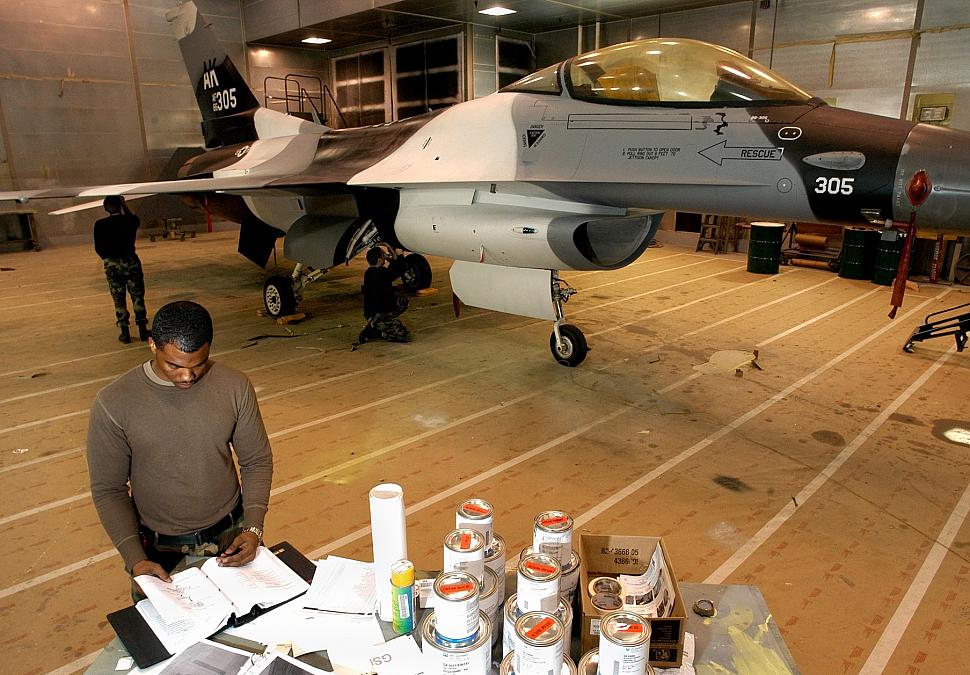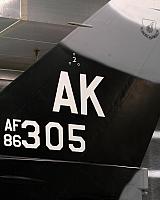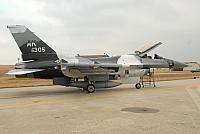Fighter Jet News
F-16 Fighting Falcon News
Kunsan Airmen paint first arctic F-16 for Eielson
December 5, 2007 (by
SSgt. Alice Moore) -
Airmen from the 8th Maintenance Squadron corrosion shop recently completed painting the first US Air Force F-16 aircraft with an arctic scheme.

The white, black and gray aircrafts will be used as aggressor planes assigned to Eielson AFB, Alaska for training exercises to include Red Flag Alaska. This is the first time an arctic scheme has been used.
Currently the Air Force has three aggressor squadrons that have the mission of replicating potential adversary aircraft in order to provide training for U.S. and coalition combat air forces, said Col. Eddie Osteen, 354th Operations Group deputy commander. There are three different paint schemes applied to Eielson's aggressors to be used during throughout the year.
"The aggressor paint scheme is used to help 'friendly' aircraft visually differentiate the 'enemy' aircraft from other friendly F-16s. This is critical to prevent fratricide when blue and red forces merge into a visual fight," Colonel Osteen said.
The Pacific Alaska Range Complex, is the training area for Red Flag-Alaska and is comprised of mountains, wooded hills and tundra, Colonel Osteen said. The colors there range from green to brown in the summer and white when the snow hits the ground during winter. The colors do not represent any specific type of aircraft or country.
"They (colors) are merely a way to quickly identify the aggressor aircraft when within visual range. The variety of paint schemes will make it more challenging to visually acquire the aggressor aircraft depending on the background, be it sky or earth."
In October, Kunsan received its initial group of block 40 F-16 aircraft under the Common Configuration Implementation Program from Eielson. In return, Eielson would be getting Kunsan's block 30 F-16s to be used as aggressor aircraft for its training exercises. To help assist Eielson with this swap, Airmen from the 8th MXS corrosion shop accepted the task of painting two F-16 planes with an arctic scheme.
"When the initial request to paint this jet at our facility came in from PACAF, we immediately accepted the challenge," said Maj. David Seitz, 8 MXS maintenance operations officer. "All we needed was paint and technical data. The data sent to us was one piece of paper with a five-inch, three-sided schematic. Our professional maintainers were able to translate that small drawing into an actual F-16."
Major Seitz said the maintainers researched existing technical orders on the best method for applying multiple colors and the two-colored stencils required to produce the finished product.
"This required round-the-clock paint crews from start to finish, as the colors must be applied while the previous color is still wet," Major Seitz said.
The job entailed sanding the old paint off the aircraft, putting primer, which is a coat that helps the paint hold better, and applying the new paint scheme colors, said Senior Airman Kevin Stevens, 8 MXS aircraft structural maintenance journeyman.
"This was a good learning experience," he said. "We were able to work with colors and paint we've never worked with. I was happy with the end result."
Currently, most of Eielson's new fleet of aircraft is being repainted as aircraft undergo Falcon Star structural modifications in South Korea, which will extend the service life of the F-16s, but the efforts of Kunsan Airmen have ensured Eielson receives enough aggressor-painted aircraft available to meet the base's needs, said Lt. Col. Mark Murphy 354th Maintenance Group deputy commander.
"Kunsan's contributions have been critical to our ability to prepare for the 2008 Red Flag-Alaska schedule. Eielson's Airmen will make up some of the difference, but even at full capacity our corrosion hangar doesn't have the ability to close the flashes on five aircraft and completely repaint two jets in the arctic paint scheme, which is no easy task with their (Eielson Airmen) workload. Thanks to Kunsan's generous assistance, Eielson should have 14 aggressor-painted aircraft available to meet April's Red Flag schedule, which wouldn't have been possible otherwise."
Major Seitz said the work put in by the corrosion shop resulted in a great product.
"Our experts overcame several challenges to produce a truly unique F-16 that will test aircrews participating in Red Flag Alaska for decades to come," he said. I'm truly proud to serve with these 'make it happen' Airmen."
The corrosion shop is currently working on the third arctic scheme F-16 that will be used in Red Flag Alaska 2008.

SSgt. Cory Goines, thumbs through a technical order manual for finishing instructions while SrA. Kevin Stevens and Matt Wuensch take care of the final details on a newly painted arctic scheme on F-16C block 30 #86-0305 on November 30th, 2007. Sergeant Goines and Amn. Stevens and Wuensch, are Aircraft Structural Maintenance Journeymen with the 8th Maintenance Squadron. The 8th MXS painted the aircraft in preparation for an upcoming Eielson/Kunsan F-16 swap. The aircraft is the first in the unit to have an arctic scheme. [USAF photo by TSgt. Quinton T. Burris]
Currently the Air Force has three aggressor squadrons that have the mission of replicating potential adversary aircraft in order to provide training for U.S. and coalition combat air forces, said Col. Eddie Osteen, 354th Operations Group deputy commander. There are three different paint schemes applied to Eielson's aggressors to be used during throughout the year.
"The aggressor paint scheme is used to help 'friendly' aircraft visually differentiate the 'enemy' aircraft from other friendly F-16s. This is critical to prevent fratricide when blue and red forces merge into a visual fight," Colonel Osteen said.
The Pacific Alaska Range Complex, is the training area for Red Flag-Alaska and is comprised of mountains, wooded hills and tundra, Colonel Osteen said. The colors there range from green to brown in the summer and white when the snow hits the ground during winter. The colors do not represent any specific type of aircraft or country.
"They (colors) are merely a way to quickly identify the aggressor aircraft when within visual range. The variety of paint schemes will make it more challenging to visually acquire the aggressor aircraft depending on the background, be it sky or earth."
In October, Kunsan received its initial group of block 40 F-16 aircraft under the Common Configuration Implementation Program from Eielson. In return, Eielson would be getting Kunsan's block 30 F-16s to be used as aggressor aircraft for its training exercises. To help assist Eielson with this swap, Airmen from the 8th MXS corrosion shop accepted the task of painting two F-16 planes with an arctic scheme.
"When the initial request to paint this jet at our facility came in from PACAF, we immediately accepted the challenge," said Maj. David Seitz, 8 MXS maintenance operations officer. "All we needed was paint and technical data. The data sent to us was one piece of paper with a five-inch, three-sided schematic. Our professional maintainers were able to translate that small drawing into an actual F-16."
Major Seitz said the maintainers researched existing technical orders on the best method for applying multiple colors and the two-colored stencils required to produce the finished product.
"This required round-the-clock paint crews from start to finish, as the colors must be applied while the previous color is still wet," Major Seitz said.
The job entailed sanding the old paint off the aircraft, putting primer, which is a coat that helps the paint hold better, and applying the new paint scheme colors, said Senior Airman Kevin Stevens, 8 MXS aircraft structural maintenance journeyman.
"This was a good learning experience," he said. "We were able to work with colors and paint we've never worked with. I was happy with the end result."
Currently, most of Eielson's new fleet of aircraft is being repainted as aircraft undergo Falcon Star structural modifications in South Korea, which will extend the service life of the F-16s, but the efforts of Kunsan Airmen have ensured Eielson receives enough aggressor-painted aircraft available to meet the base's needs, said Lt. Col. Mark Murphy 354th Maintenance Group deputy commander.
"Kunsan's contributions have been critical to our ability to prepare for the 2008 Red Flag-Alaska schedule. Eielson's Airmen will make up some of the difference, but even at full capacity our corrosion hangar doesn't have the ability to close the flashes on five aircraft and completely repaint two jets in the arctic paint scheme, which is no easy task with their (Eielson Airmen) workload. Thanks to Kunsan's generous assistance, Eielson should have 14 aggressor-painted aircraft available to meet April's Red Flag schedule, which wouldn't have been possible otherwise."
Major Seitz said the work put in by the corrosion shop resulted in a great product.
"Our experts overcame several challenges to produce a truly unique F-16 that will test aircrews participating in Red Flag Alaska for decades to come," he said. I'm truly proud to serve with these 'make it happen' Airmen."
The corrosion shop is currently working on the third arctic scheme F-16 that will be used in Red Flag Alaska 2008.
Courtesy of 8th Fighter Wing Public Affairs
Additional images:




Newly painted F-16C block 30 #86-0305 sits in the 8th Maintenance Group paint barn and corrosion section on November 30th, 2007. Members of the 8th Maintenance Squadron painted the aircraft in preparation for an upcoming Eielson/Kunsan F-16 swap. This is the first F-16 with an arctic scheme. [USAF photo by TSgt. Quinton T. Burris]

USAF F-16C block 30 #86-0314 painted with an arctic paint scheme waits for clearance before taking off for a training mission from Kunsan AB on December 7th, 2007. The new paint scheme will be used during training missions to resemble an aggressor aircraft when the jet is transferred to Eielson AFB. [USAF photo by TSgt. Quinton T. Burris]

USAF F-16C block 30 #86-0305 painted with an arctic paint scheme sits outside a hardened shelter at Kunsan AB after a training mission on December 7th, 2007. The new paint scheme will be used during training missions to resemble an aggressor aircraft when the jet is transferred to Eielson AFB. [USAF photo by SrA. Giang Nguyen]
Related articles:
Forum discussion:
Tags
- 8 FW commander & RoKAF fly in training mission (2007-11-16)
- Wolf Pack AFE techs upgrade pilot equipment (2007-11-04)
- Kunsan receives upgraded F-16 fighters (2007-10-05)
- U.S. upgrades F-16s in South Korea (2006-12-01)
- F-16 Fighting Falcon news archive
Forum discussion:
- Kunsan Airmen paint first arctic F-16 for Eielson ( 134 replies)
Tags
